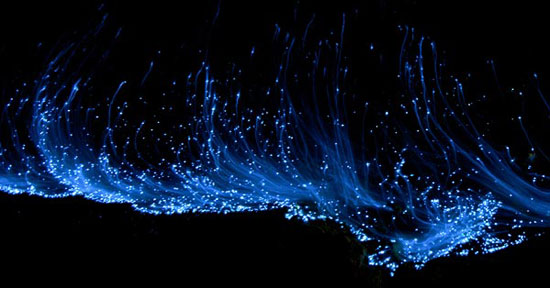4.16.14 – The boisterous conversation between sky and sea that was supposed to last 12 hours lasted 36 instead and dealt us winds up to 35 knots … making for some fun times. While we are now riding along towards the trade winds, we’re also pushing into the waves of the previous outburst. The cloud cover has been thick, which has prevented us from viewing either the sun or the eclipse of the full moon. This morning however, I was treated to a most wonderful sunrise.
So, while we enjoy the sunshine and mid-70’s temperatures and continue to sort our way towards the Galapagos Islands, we wanted to share our experience of the amazing bio-illumination phenomena that we’ve witnessed several times on this voyage. So, read on to get the story … first my own experience … followed by Tegan Mortimer’s terrific scientific explanation. So that said, let’s get illuminated!
________________________________________________________________
:: The Wonder of Bioluminescence
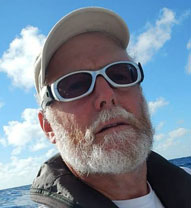 Dave Rearick: One afternoon right around New Year’s, not long after leaving Cape Town, I crossed paths with a fishing boat – a traditional colorful wooden boat painted in bright greens, yellows and reds. As our two courses passed, the captain contacted me and we spoke for a few moments over the radio; I found his English was excellent with a smooth, lyrical accent to it. We talked of the beautiful weather and seeing that I was sailing east and away from Africa, he asked me where I was headed. New Zealand I told him … and alone! He marveled at that and wished me great luck, explaining that I should have good weather since it was now summer, and then he told me to watch for the bioluminescence which he assured me I would find very beautiful. With that, we said our goodbyes – he headed off to another fishing ground and I proceeded on my way east.
Dave Rearick: One afternoon right around New Year’s, not long after leaving Cape Town, I crossed paths with a fishing boat – a traditional colorful wooden boat painted in bright greens, yellows and reds. As our two courses passed, the captain contacted me and we spoke for a few moments over the radio; I found his English was excellent with a smooth, lyrical accent to it. We talked of the beautiful weather and seeing that I was sailing east and away from Africa, he asked me where I was headed. New Zealand I told him … and alone! He marveled at that and wished me great luck, explaining that I should have good weather since it was now summer, and then he told me to watch for the bioluminescence which he assured me I would find very beautiful. With that, we said our goodbyes – he headed off to another fishing ground and I proceeded on my way east.
Up to that point, my direct experience with bioluminescence had been memorable but limited. But a few nights after I left the fisherman, I stepped into a world of bioluminescence that was unlike any I even knew existed. Let me tell you, that fisherman knew of what he spoke.
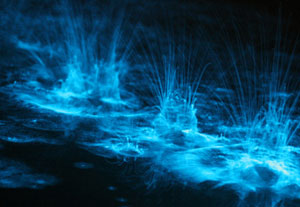 The experience of sailing through a floating forest of bioluminescence steals away any words you might offer up to describe it.
The experience of sailing through a floating forest of bioluminescence steals away any words you might offer up to describe it.
It is all just so simple and elegant; a photograph would be impossible – though still we try. If I could draw you a picture, I would … but I know even that would fall short.
As I stood and looked forward, Bodacious Dream sailed along, rising up and bumping her way over the tops of small waves, sending out splashes of a wake to either side, which appeared to be lit indirectly from a light beam located directly underneath the boat – but of course there was no light down there. The glowing white froth of the wake glowed bright, artificial and surreal. As if that wasn’t enough on its own, looking back behind the boat provided an intoxicating view.
Bodacious Dream has two rudders, one on each side of the boat approximately 5 feet to each side of the centerline. From the centerline, the hydro-generator drops into the water from the stern of the boat. Standing near the mast of the boat and looking aft, the entire wake of the boat was fully aglow … tossing dancing sparks glittering across the water. Like I said, it was as if Bo had this bright swimming pool light underneath her pointing aft, beyond the transom.
Leaving the foredeck and walking toward the stern and looking over the edge, revealed an entirely different and no less spectacular show.
A couple of feet below the water, off the slender tip of each rudder, there were these luminous streamers – not unlike what you might see flying from the top of tent poles at Renaissance Fairs … long, slender and snaking back and forth in the wind. Looking further under the water, you could see they glowed white-green and extended back for maybe 12 or 15 feet beyond the boat. Wavering back and forth, the ends subdividing into three or four strips, each waving independently and criss-crossing back and forth over each other. Off the centerline and close to the hydro-generator, a plume of glowing white bubbles rose up, not as sleek and mesmerizing as the streamers, but giving a round and ruddy glow to the surrounding waters. The water above, below and all around the rudders and hydro was clear, with all their outer edges carefully defined and illuminated by thous delicate refracted light.
While on one hand, this was something I could have sat and watched for hours, on the other, something about it felt almost indecently beautiful – like something SO beautiful that you felt you shouldn’t stare at it, least it lose its genius and grow too quickly mundane to human eyes. As I continued to stare at it, I felt it expressed something so beyond the eyes of man, that I couldn’t help wonder what other surprises waited for us … out there over the horizon and beyond the stars.
And in the middle of that, I recalled what my fisherman friend had said to me, “Ahh yes … and you will surely enjoy the bioluminescence. It is so beautiful at night. Be safe my friend and have a good journey.” Yes indeed, my friend! Thank you!
– Dave
34.1974S, 109.2991W
________________________________________________________________
:: Tegan’s Science Notes #7 – The Science of Bioluminescence
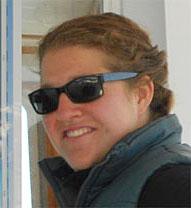 As Dave’s story reaffirms, bioluminescence is a truly spectacular phenomenon! Phrases like “a sea of stars” are used to describe what it looks like and that is completely accurate. If you’ve ever seen a firefly or lightning bug, you’ve seen bioluminescence!
As Dave’s story reaffirms, bioluminescence is a truly spectacular phenomenon! Phrases like “a sea of stars” are used to describe what it looks like and that is completely accurate. If you’ve ever seen a firefly or lightning bug, you’ve seen bioluminescence!
But what is it actually? Bioluminescence is the ability for some animals to create light through a chemical process called “chemiluminescence.” Two chemicals are required for this reaction: “luciferin” and either “luciferase” or “photoprotein.” Luciferase is an enzyme that interacts with oxidized (oxygen-added) luciferin in a chemical reaction that results in the creation of light. Some animals create luciferin themselves and some acquire it by eating other animals or by having a symbiotic relationship with a luciferin-creating organism. Bioluminescent shrimp have a symbiotic relationship with luciferin-creating bacteria that lives in their guts. The shrimp gets light and in trade the bacteria get somewhere to live. That’s a symbiotic relationship: everybody wins!
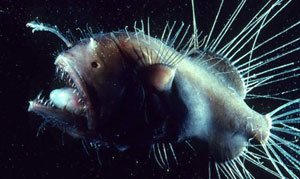 I mentioned fireflies, but most bioluminescent organisms live in the ocean, especially in the deep sea where it is completely dark. The most famous bioluminescent animal of the deep sea is probably the anglerfish, (pictured to the left) which has a bioluminescent lure that hangs directly above its tooth-filled mouth, just waiting for smaller prey to be attracted to the anglerfish’s glowing light.
I mentioned fireflies, but most bioluminescent organisms live in the ocean, especially in the deep sea where it is completely dark. The most famous bioluminescent animal of the deep sea is probably the anglerfish, (pictured to the left) which has a bioluminescent lure that hangs directly above its tooth-filled mouth, just waiting for smaller prey to be attracted to the anglerfish’s glowing light.
So what is Dave seeing? It’s definitely NOT thousands of anglerfish under Bodacious Dream! What Dave is seeing is bioluminescent “plankton.” There are many different types of plankton, both “phytoplankton” (little plants) and “zooplankton” (little animals) can be bioluminescent but two types: “copepods” and “dinoflagellates” are the most commonly seen. Unlike the anglerfish that uses its bioluminescence to attract prey, these tiny planktons use bioluminescence to avoid getting eaten. When they are disturbed, either by a predator, or a human diver, or even by a boat like Bodacious Dream moving through the water, they emit a light, which is thought to startle and repel whatever might have been planning on eating the plankton.
Scientists think that some species of sharks and whales put the plankton’s defensive bioluminescence to use in helping the larger creatures to hunt. Sperm whales for example will go to an area with large amounts of bioluminescent plankton. When the plankton’s predators (fish or squid) approach, the plankton’s light alerts the whale who is then able to more easily catch the fish. Neat trick!
– Tegan
:: For more exciting science insights and opportunities, please check out our BDX Explorer Guides or stop by our Citizen Science Resources page, where you can also find all of Tegan’s previous Science Notes, Also, we welcome your input or participation to our BDX Learning and Discovery efforts. You can always reach us at … <oceanexplorer@bodaciousdreamexpeditions.com>
:: BDX Website :: Email List Sign-Up :: Explorer Guides :: BDX Facebook

